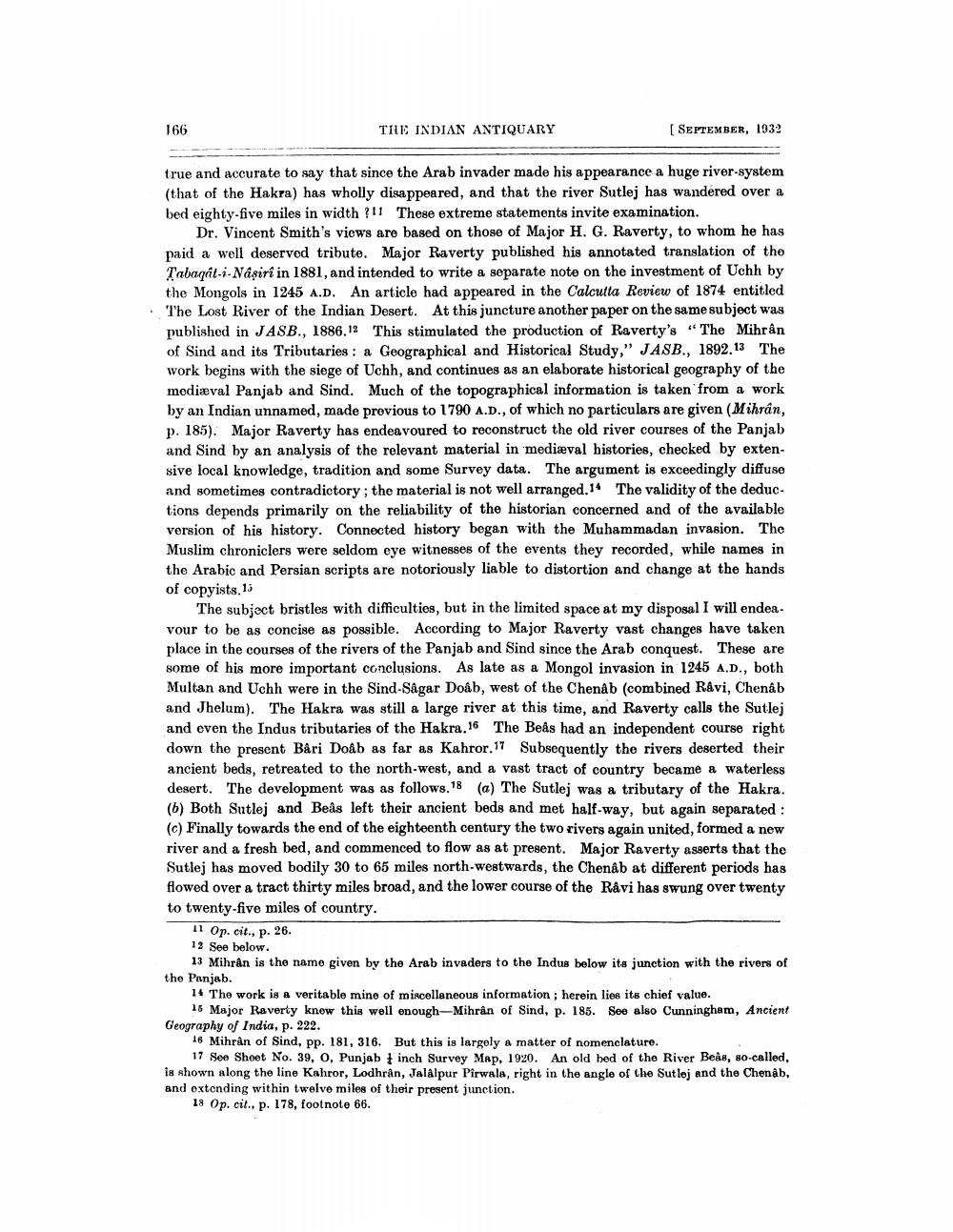________________
166
THE INDIAN ANTIQUARY
[ SEPTEMBER, 1932
true and accurate to say that since the Arab invader made his appearance a huge river-system (that of the Hakra) has wholly disappeared, and that the river Sutlej has wandered over a bed eighty-five miles in width ?11 These extreme statements invite examination.
Dr. Vincent Smith's views are based on those of Major H. G. Raverty, to whom he has paid a well deservod tribute. Major Raverty published his annotated translation of the Tabagat--Naşiri in 1881, and intended to write a separate note on the investment of Uchh by the Mongols in 1245 A.D. An article had appeared in the Calcutta Review of 1874 entitled The Lost River of the Indian Desert. At this juncture another paper on the same subject was published in JASB., 1886.12 This stimulated the production of Raverty's “The Mihrân of Sind and its Tributaries : a Geographical and Historical Study," JASB., 1892.13 The work begins with the siege of Uchh, and continues as an elaborate historical geography of the modiæval Panjab and Sind. Much of the topographical information is taken from a work by an Indian unnamed, made previous to 1790 A.D., of which no particulars are given (Mihrán, p. 185). Major Raverty has endeavoured to reconstruct the old river courses of the Panjab and Sind by an analysis of the relevant material in mediæval histories, checked by extensive local knowledge, tradition and some Survey data. The argument is exceedingly diffuse and sometimes contradictory; the material is not well arranged.14 The validity of the deductions depends primarily on the reliability of the historian concerned and of the available version of his history. Connected history began with the Muhammadan invasion. The Muslim chroniclers were seldom eye witnesses of the events they recorded, while names in the Arabic and Persian scripts are notoriously liable to distortion and change at the hands of copyists. 15
The subject bristles with difficulties, but in the limited space at my disposal I will endeavour to be as concise as possible. According to Major Raverty vast changes have taken place in the courses of the rivers of the Panjab and Sind since the Arab conquest. These are some of his more important conclusions. As late as a Mongol invasion in 1245 A.D., both Multan and Uchh were in the Sind Sagar Doab, west of the Chenab (combined Ravi, Chenab and Jhelum). The Hakra was still a large river at this time, and Raverty calls the Sutlej and even the Indus tributaries of the Hakra.16 The Beas had an independent course right down the present Båri Doåb as far as Kahror. 17 Subsequently the rivers deserted their ancient beds, retreated to the north-west, and a vast tract of country became a waterless desert. The development was as follows.18 (a) The Sutlej was a tributary of the Hakra. (6) Both Sutlej and Beds left their ancient beds and met half-way, but again separated : (c) Finally towards the end of the eighteenth century the two rivers again united, formed a new river and a fresh bed, and commenced to flow as at present. Major Raverty asserts that the Sutlej has moved bodily 30 to 65 miles north-westwards, the Chenab at different periods has flowed over a tract thirty miles broad, and the lower course of the Ravi has swung over twenty to twenty-five miles of country.
nl Op. cit., p. 26. 12 See below.
13 Mihran is the name given by the Arab invaders to the Indus below its junction with the rivers of the Panjab.
14 The work is a veritable mino of miscellaneous information; herein lies its chief value.
16 Major Raverty knew this well enough-Mihren of Sind, p. 185. See also Cunningham, Ancient Geography of India, p. 222.
16 Mihrån of Sind, pp. 181, 316. But this is largely a matter of nomenclature.
17 See Sheet No. 39, O, Punjab inch Survey Map, 1920. An old bed of the River Beå, so-called, is shown along the line Kahror, Lodhrán, Jalalpur Pirwala, right in the angle of the Sutlej and the Chenab, and oxtending within twelve miles of their present junction.
18 Op. cit., p. 178, footnote 66.




